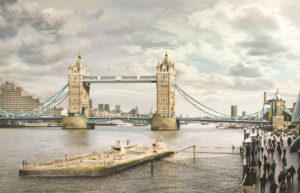Thames Baths is the Kickstarter project inspired by a an open call for future ideas for the River Thames to create a lido on the Thames. The project has 1,273 supporters including Tracey Emin CBE, and project designs are being led by Studio Octopi.
Potted history of lidos on the Thames
Lidos (outdoor public pools), enjoyed by people across the world, are not a new concept for London or the Thames. There was a floating lido at Victoria Embankment 1875-1885, and they were considered of national importance during interwar years. Recognising the health benefits of being outdoors, there was a concerted drive to make London a ‘city of lidos’.
As public amenities, lidos have been seen as community builders too, where people of all walks of life can come to enjoy the water and fresh air. In 1936, Sir Josiah Stamp, a director of the Bank of England, noted: “Bathing reduces rich and poor, high and low, to a common standard of enjoyment and health. When we get down to swimming, we get down to democracy.”
Modern day plans for a sustainable lido
While the concept is not new, the Thames Baths will be a modern and sustainable year-round outdoor swimming facility that swimmers and non-swimmers, local people and visitors alike can enjoy and use to get back to nature.
Finding the right location is not straight forward – there are stretches of the river where you must not swim – currently there are three sites under consideration and the project team are keen to go to planning on one in 2021.
When permission is approved, facilities will include a heated pool and cold water pool, as well as changing rooms, seating areas, café, and shop. Depending on location, plans may also include a sauna and hot tubs, and community spaces which could be an asset for everyone, particularly water interest groups or schools.
Chris Romer-Lee, co-founder, says “I had the idea when I was on holiday standing on the edge of Lake Zurich enjoying outdoor swimming with my family. It’s such an asset for the city, I wondered if we could swim in the Thames safely? The water quality is better than you’d think and there’s a long history of swimming in the Thames. I am determined to bring Thames Baths to life and make use of today’s wonderful sustainable technology available. Watch this space!”
Kate Willard OBE, Thames Estuary Envoy comments: “I would love to see a lido on the Thames one day. They are excellent facilities that allow everyone to connect with nature and our river, which is key to us respecting and looking after them. The degrees to which the Thames Baths will use green energy in the build and operation is inspiring, and I am delighted to welcome them as an Estuary Visionary.”

Artist impression of a lido on the Thames. Photo credit: Studio Octopi and Picture Plane
Using green technology to create an eco-friendly Lido on the Thames
Thames Baths are working to minimise their carbon footprint both in construction and operation. Depending on where the lido is built, plans include using:
Recycled River Water – Water in the pools will come from the river, and will be filtered using a chemical-free method that has been tried and tested in Germany and meets stringent German FFL standards.
Tidal Energy – It may not be feasible to use Thames’ strong tidal energy to heat the water as it would require huge (4no. 3m diameter) turbines along the side of the pontoon. However smaller turbines on the underside of the pontoon could provide power for LED lighting, power sockets etc.
Geothermal Energy – Geothermal energy has been successfully used at Jubilee Pool in Penzance. In summary this works by extracting warm water from a deep geothermal well, taking heat out of that water and distributing it to the pool, before re-injecting the cooler water back into the ground. This allows the temperature of the pool to be sustained with a very low carbon footprint.
Using waste heat – Another idea is to use waste heat from offices to heat the water. In Sweden, there are several examples of waste heat being reused to produce heating and hot water. The use of waste heat is enabled by the country’s district heating infrastructure, which, in 2016, supplied more than 57% of all buildings in Sweden with heat and hot water. Based on statistics gathered from Swedish district heating producers, more than 45% of all the heating generated in 2018 came from sources of waste heat.
To find out more visit thamesbaths.com and octopi.co.uk to see other swimming projects.
If you would like to nominate your organisation or one you know to become a Visionary please get in touch.
